#Amalgam Clark Kent
Text

What If Season 2 was amazing and while we wait for season 3 I'll be imagining a beautiful world where we could get an Amalgam Universe episode 😌😌
216 notes
·
View notes
Text
DP × DC Micro Idea #1
Kryptonite was a naturally occurring crystal of varying colors on Krypton that were able to affect Kryptonians either mentally or physically. The original colors were blue and red. Platinum was accidentally made from blue kryptonite in one of the Science Guild's labs, but due to no non-Kryptonians being near it, none of the scientists knew what it did.
From the death and destruction of the Kryptonians, a massive amount of ectoplasm was created. This fused with some of the stones. Some blue taking on a greenish tone and some red turning pink. A small amount of the platinum turned gold. After landing on Earth, some were able to modify these stones further.
Due to the kryptonite being ecto-contaminated, Danny Fenton (Phantom) is able to remove the radiation from it which would then return them to their original states.
#dc x dp#dp x dc#dc comic#kryptonian#clark kent#kara zor el#kryptonite#danny fenton#danny phantom#dp x dc micro idea#smallville#supergirl#superman#i don't know how to tag#amalgamation of others ideas that triggered my own
205 notes
·
View notes
Text
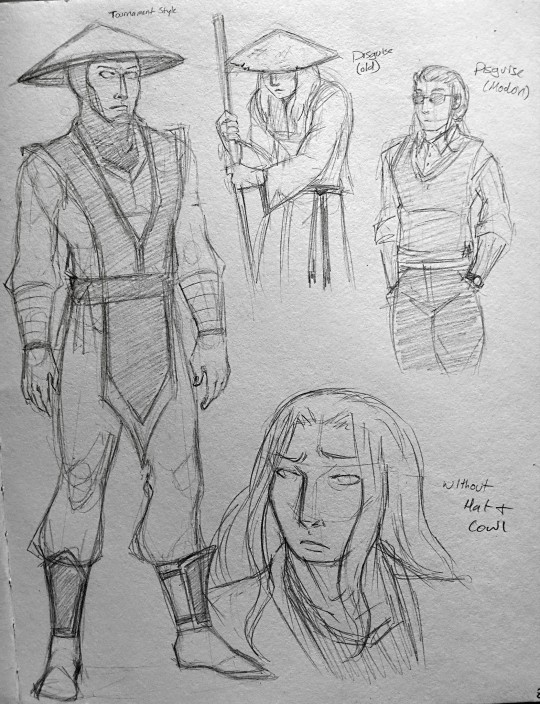
Any fans of the Thunder God here?
#gopher art#sketchbook#mortal kombat#mk raiden#just playing around with amalgamating the designs. which ends up being a simplified version of one of his more complicated designs. i guess#also messing with the idea of film raiden and his disguise. i genuinely think that would be fun to play with in his gameverse character#the only issue is that he's. kinda. canonically 7 ft tall. which is hard to ignore. whatever. clark kent logic#also the modern disguise i doodled makes him look like one of those gay bitches on my dash. whats his name. crowley? is that the dudes name?#either way. it was subconscious#raiden is very babygirl with his hair down. its a good look for him. if only he wasnt a collosal idiot in canon
101 notes
·
View notes
Text

Drew Super Soldier design by Oni18064
16 notes
·
View notes
Text




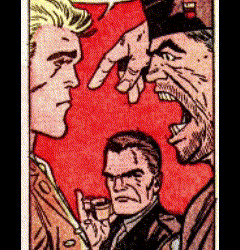
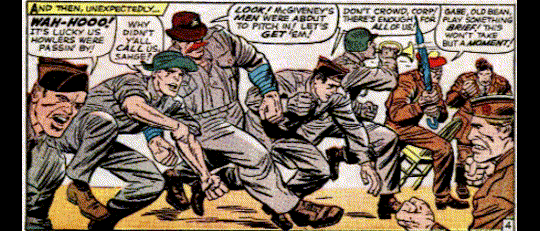
Super Soldier Man of War #1 (1997) and Sgt. Fury and His Howling Commandos #13 (1964)
Co Plotters Mark Waid and Dave Gibbons pay homage to Co Plotters Stan Lee; During the Amalgam Comics event in which several Heroes and Villains from both DC and Marvel Comics are combined in new and interesting ways; Notably as seen here Captain America and Superman, the panels we see here are direct reference to Cap's first meet with the Howlers from their comics thirteenth issue.
#Amalgam Comics#Super Soldier#Super Soldier (Clark Kent)#Superman#Sergeant Rock#Jimmy Olsen#DC Comics#Marvel Comics#Sergeant Fury#Captain America#Mark Waid#Dave Gibbons#Stan Lee#Jack Kirby#Howling Commandos#War Comics#Superhero Comics#1964#1997#Comic Crossovers#Bucky Barnes#Steve Rogers#Clark Kent#Nick Fury#Homage#Comic Book GIFS#Comic GIFS#Amalgam#Marvel#DC
8 notes
·
View notes
Text
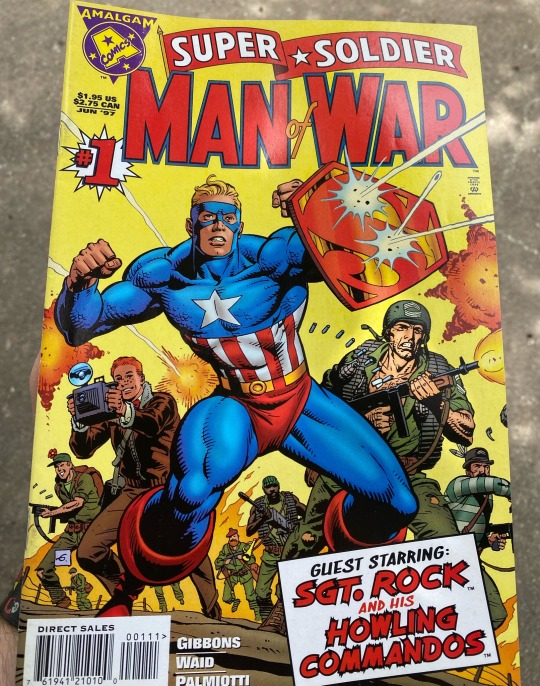

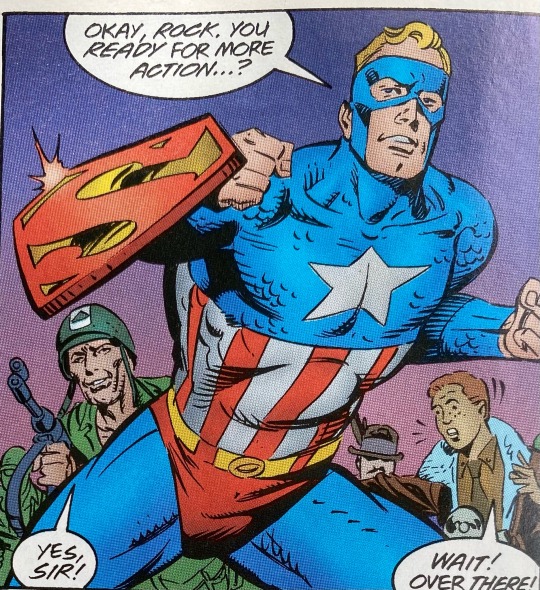

Who else loves Amalgam?!
#dc comics#marvel#amalgam#amalgaverse#amalgam comics#super soldier#clark kent#steve rogers#mark waid#dave gibbons#john kalisz#jimmy palmiotti#90s comics#angus mckie
19 notes
·
View notes
Text
they casted a Jewish actor to play Clark Kent in Superman legacy, now they just need to cast a nice Jewish boy to play Hercules in the live action and we are so fucking back
#Real cinema is back#david corenswet bringing superman back to his Jewish origins#There is something sooooo Tom Welling Clark Kent Smallville about that man#Also they way Hercules (1997) is an amalgamation of classical jewish and Superman/superhero influences..... I can go on and on#They would be the best of friends....my two big handsome farmboys#Once legacy and my adventures with superman comes out....I will be reverting back to MY origins as a superman best hero all time truther
7 notes
·
View notes
Text
Vedic Astrology Observations
Moon Dominant Men: “Deep and Mysterious”
🌖🌗🌘🌑🌒🌓🌔

(GIF context: Taken from Shadowhunters depicting a gay couple with Matt Daddario (left) who is Moon Dominant [Hasta sun and ketu with ketu as moon nakshatra ruler] and Harry Shum Jr. (right) who is Rahu Dominant [Ardra moon and Swati Jupiter with Sun in Jupiter ruled nakshatra]. Both actors identify as straight.)
In Vedic astrology, the Moon, or “Chandra”, occupies a position of profound significance. It is coveted as the very embodiment of the mind, a symbol resonant with clarity, reflection, instincts, and cycles, which when combined come to form what we know as perceptual consciousness. Like the Moon, which shines by reflecting the Sun's light, the mind similarly reflects its environment. It captures and reinterprets external stimuli, forming a consciousness that is, in essence, an image similar to that of a mirror of the surrounding world. In Vedic astrology, the Moon is a celestial body that stands as the fundamental indicator of one’s capacity for emotion and extends to one’s ability of cogitation, shaping the manner in which thoughts and emotions are processed and articulated. In contrast to Western philosophical perspectives, which tend to dichotomize emotions and logic, framing them as diametric to one another, Vedic astrology presents the Moon as a mediator that brings the two faculties together through upholding the position that our cognitive and decision-making processes are inextricably linked with emotional undercurrents. It echoes a sentiment that, even in endeavors that ostensibly try to prioritize objectivity, such as with epistemological pursuits, true objective knowledge is nothing but an elusive ideal. This stems from the notion that our perception forms our reality, encapsulated in the phrase, “I am my universe.” This is where the significance of the Moon in Vedic astrology becomes particularly relevant. It posits the idea that our subconscious greatly influences our conscious mind, thereby molding our individual perceptions of reality and shaping the way we experience the world. It recognizes the limitations in our control over our mental faculties and how emotions actively play a part in deciding our thoughts and life trajectories, whether we like it or not. This allows the symbolism of the Moon in Vedic astrology to effectively capture the human condition's amalgamation of thought and feeling, thereby speaking to the interaction of light and shadow in the psyche and the ongoing process of mental transformation.
Men with a pronounced lunar influence in their astrological charts, notably distinguished by those with primary placements (Sun, Moon, or Ascendant) in or aspects with Moon-ruled nakshatras such as Rohini, Hasta, and Shravana (planetary dominance can be determined in more subtle ways as well), present an intriguing study into the nuanced expressions of masculinity and relational dynamics. Examples of Public figures like Henry Cavill, with his Shravana Ascendant and Moon in the first house, or fictional characters like Flynn Ryder, voiced by an actor with a Hasta Sun and Rohini Moon, exemplify a unique blend of characteristics associated with lunar dominance that I will continue to explore further.
(GIF and image contexts: The first GIF shown depicts Henry Cavill as Clark Kent in Man of Steel. The second is an image showing the fictional character Flynn Ryder side by side with his voice actor Zachary Levi.)
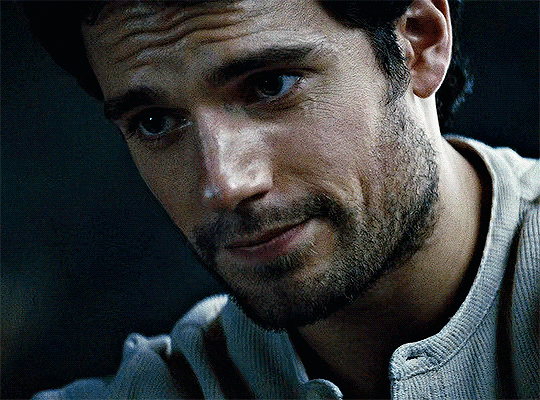
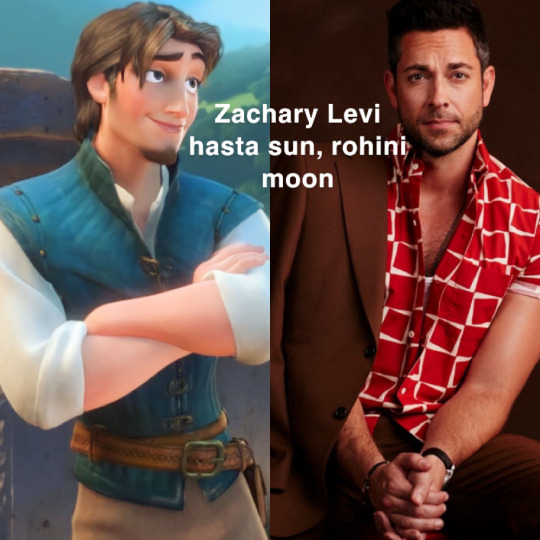
The influence of the Moon on men can be understood through the influence of the mother and the lens of "Yin and Yang" in Eastern philosophy. In Vedic astrology, the Moon's connection with the mother can be said to link the development and characteristics of individuals to the amount of nurture and emotional sustenance they were provided with as a child. This nurturing shapes the robusticity of their intrinsic Yin qualities – receptivity, passivity, intuition, and a deep connection with the maternal aspects of life, often linked to the feminine. These qualities are further symbolized by the Moon and its cycles, traditionally associated with menstruation, highlighting the cyclical and nurturing features of femininity. In contrast, Yang represents the dynamic, assertive, and outward energy projection, typically linked to the masculine and more solar sattvic energies. Men with Moon-dominance in their astrological profiles embody this Yin energy, exemplifying a reflective masculinity and an inward understanding of femininity. This inward orientation of Yin, shaped significantly by the emotional and nurturing bond with mother figures, provides these men with a deeper understanding and connection to various feminine aspects of life. At the same time, the outward orientation of Yang allows for an external connection to the masculine, producing a self-identified masculinity that is introspective and emotionally/mentally attuned to the feminine while still being confident in its own nature. This ultimately does have a dampening effect on their exhibition of traditionally masculine behaviors, being that men as a whole are ruled by the Sun and are said to be more solar, while women as a whole are ruled by the Moon and are said to be more lunar. (The 24-hour circadian rhythm is based on the male hormone cycle and aligns with the Earth's orbit relative to the sun, while women have what is known as an infradian rhythm, which follows the 28-day lunar cycle, for reference). This internal emphasis on Yin but external reflection of Yang in Moon-dominant men's personalities makes them emotionally rich and empathetic, displaying a unique blend of masculine and feminine energies that is both introspective and in harmony with the external world. The Moon serves to harmonize the intense energy of the Sun, offering calming and nurturing attributes, ultimately leading to the formation of a kind of masculinity in these men that is fluid and can express strength in gentleness and assertiveness in sensitivity. However, this can also make them uniquely susceptible to certain challenges, which I will continue to discuss further in the following paragraphs.
The Moon is also tied with its nodes: Rahu and Ketu, the two mathematical points where the Moon's orbit meets the ecliptic (if you didn’t know, the Moon does not directly follow the ecliptic itself, which is the sun's path in the sky; it’s about 5° off approaching either node). The Moon's astrological significance is intricately linked to Rahu and Ketu, with all three governing distinct facets of consciousness. Rahu, often depicted as the head of a dragon or the head without a body, symbolizes material desires and is associated with the future, representing the qualities we need to develop and the experiences we must have to grow. Rahu is primarily concerned with the rational mind and the projection of consciousness into the material realm, epitomizing ambition, desire, and worldly aspirations. It represents the part of the psyche that is outwardly focused, engaging with the tangible aspects of life that are said to paradoxically represent the illusion of Maya. Conversely, Ketu, commonly depicted as the dragon’s tail or a headless body, represents detachment, spirituality, and the internal journey. It is associated with the past and karmic baggage, indicating the lessons we have learned and the experiences we must release to evolve through Samsara to achieve Moksha. Ketu is about letting go and achieving spiritual enlightenment. It is associated with intense spirituality, introspection, and the aspects of the psyche that delve into the depths of the subconscious and the ineffable. Ketu represents the part of the mind that seeks to understand and connect with the intangible, the mystical, and the existential. (In Vedic mythology, Rahu and Ketu are said to be the same demon killed by Vishnu)
The Moon acts as a mediating conduit between these two nodes, attempting to balance the rational, materialistic impulses of Rahu with the spiritual, introspective tendencies of Ketu. It symbolizes the emotional and perceptual aspects of consciousness, playing a supreme role in how feelings and intuition are integrated with rational thought and spiritual insight. The Moon's position in a chart thus reflects the ongoing dance between the material and spiritual dimensions of human existence, influencing how individuals perceive and interact with the world around them. And because the moon works with the energy of both nodes, we can gain knowledge into the expression of Moon-dominant individuals by looking at aspects of Rahu-dominant and Ketu-dominant natives.
Rahu-dominant men often exhibit a desire for control, particularly in their mental environments. Their creativity often manifests in unique, sometimes eccentric ways, setting them apart in their expression and thought processes. These individuals typically lean towards liberal ideologies, embracing progressive and forward-thinking concepts but is often against society as a whole. Rahu-dominant men are often driven by ambition and a desire to achieve success and recognition. They are inclined to be more outwardly assertive in their quest for control, sometimes pursuing their goals with a relentless, almost aggressive, determination. This pursuit often leads them to challenge established norms and push boundaries, both socially and professionally. And while Moon-dominant men share traits with Rahu-dominant men, they exhibit distinct differences in how these characteristics are expressed and integrated into their personalities. Moon-dominant men tend to internalize their need for control, focusing more on emotional and psychological self-mastery. They are more concerned with understanding and regulating emotions rather than exerting control over external circumstances for the sake of gaining power, and they are more satiated with what they have rather than desiring what they don't, making them less materially-orirented than Rahu. Rahu men often have an obsession with external appearances and how others perceive them, trying to enforce their own rules or standards on others in order to gain the upper hand, but Moon men just want to maintain their own sense of security. They may still try to subtly reshape situations though, not to become the dominant power, but as a means to maintain their personal well-being, even at times to the detriment to others. Additionally, their approach to creativity is more reflective and introspective than what you might expect to see from Rahu, often drawing from deep emotional reservoirs and personal memories. Moon-dominant men may too challenge conventional thinking like Rahu dominant men, but their methods are typically more subtle and under the radar. For example, if a Moon-dominant man wants to avoid an arranged marriage, he might subtly express concerns or sadness about the marriage in a manner that is meant to gently persuade his family to rethink their decision. Simultaneously, he might engage in covert actions to disrupt the arrangement, such as discreetly creating scheduling conflicts and other minor obstacles that prevent it from happening efficiently as if to send unconscious signals that it was not "meant to be." In more extreme instances, he may feign agreement, choosing instead to engage in extramarital affairs, all while maintaining a cloak of compliance to avoid direct confrontation. This is in stark contrast to a Rahu man who will openly question and criticize the tradition, speaking out against his family to say it is stupid, and he may even actively rebel against it by running away to marry someone else.
(Add-on: both Rahu and Moon men possess an acute awareness of the perils of straying too far from rationality and thus are inclined to maintain a strong connection with external reality. They may encounter challenges when they engage too much with the immaterial, like dreaming, drugs, alcohol, gambling, etc., leading to their connection with external reality becoming tenuous. This disconnection can lead to issues such as escapism, addiction, and emotional disturbances, so be wary and try not to get to the point of obsession where you lose sight of your life.)
Conversely, Ketu-dominant men often possess a deep internal focus and an inclination towards introspection. Ketu-dominant men are often characterized by their profound spiritual orientation and a tendency towards seeking inner peace and enlightenment. They may exhibit a strong interest in the metaphysical or the mystical, delving into areas that transcend the material world. This spiritual pursuit often leads them to detach from worldly ambitions and superficial desires, making them appear aloof or disinterested in material success, paradoxically leading them to attract immense power. They tend to absorb energy from their surroundings, revealing truths in impactful ways and arousing servitude in others due to their stilled, void-like nature that makes people want to give to these men tirelessly. Ketu-dominant men might display a more pronounced detachment from their emotions. While they are capable of deep feeling, they often approach their emotions from a place of observation and analysis, rather than immersion. This detachment can sometimes be misinterpreted as coldness or indifference, but it is more accurately a sign of their deep internal processing and preference for solitude. Moon-dominant men, while sharing certain introspective and internal qualities with Ketu-dominant individuals, exhibit these traits in distinctly different ways, shaped by the unique lunar influence. while Moon-dominant individuals also exhibit introspection and depth, their focus is more on the emotional and psychological features. They are keenly attuned to the nuances of their own emotions as well as those of others, and this emotional sensitivity often translates into a strong sense of empathy and an intuitive understanding of human nature. Unlike the Ketu-dominant detachment, Moon-dominant men are more engaged with their immediate environment, forming deep emotional connections and valuing interpersonal relationships more than Ketu men (note that this also depends on the placement of moon in the chart as a whole, like 12 house Moon in Jyeshtha will be more Ketu-like for example). Moreover, Moon-dominant individuals may exhibit a fluctuating nature, akin to the waxing and waning phases of the Moon. They can be adaptable and receptive, often reflecting the energies around them, which can lead to a rich, albeit sometimes confusing, emotional life. This contrasts with the more consistent, inward-focused nature of Ketu-dominant men, who may remain unfazed by external circumstances, steadfast in their introspective approach for better or worse. People are drawn to both Moon and Ketu dominant men due to their compelling allure of hiddenness, but unlike the Ketu man that will remain still and almost hollow, absorbing all of the energy and power they come in contact with through their tamasic nature, Moon men will reflect energy back. This reflection of energy, softer and more reciprocal, differentiates Moon-dominant men from their Ketu-dominant counterparts, in the way that it doesn’t illicit as much discomfort in others. What usually happens with Ketu men is that others sense their inherent “emptiness,” which causes them dis-ease to the point where they will shower these men with energy in hopes that doing so will change the Ketu man or stabilize him. But Ketu men don’t work like that; their purpose is to take and consume, so no matter how much energy people give them, it is never going to be enough to make that penetrating uneasiness they give off go away. This isn’t a bad thing though. In fact, it is beneficial to the energies whose purpose it is to give, like Jupiter. It just comes down to the role people are meant to serve in this life. The differences between Moon and Ketu men highlight the unique ways in which they connect with and respond to the world around them as it relates to their Dharma.
Connecting Rahu and Ketu, because of the Moon’s relationship with both of these astrological energies, Moon-dominant natives will not only resonate with the powerful spiritual and subconscious layers of Ketu, but also to the more tangible, worldly, and reasoned aspirations represented by Rahu. This connection with Rahu and Ketu instills Moon-dominant men with a magnetic charm, characteristic of Ketu men, that is less domineering and still grounded in the more rational world of Rahu, making their allure more accessible and relatable to others. Unlike the piercing, sometimes overwhelming and obsessive depth of Ketu and the overbearing frigidity and judgments associated with Rahu, the Moon's influence results in more of a balanced persuasive appeal, empowering them with an immensely vitalizing aura. Overall, while there is a resemblance between the effects of Rahu/Ketu and the Moon, the way they manifest and are perceived is distinct. I think it bears mentioning that since the Moon deals with the energies of both, its natives are also susceptible to accompanying pitfalls for either. Because despite their inter-relation, the Moon’s integration of these energies can be messy. Rahu and Ketu are the extremes, which can end up eclipsing the Moon and/or the Sun, “swallowing” their energies (light) to try and destroy them. This solidifies the nodes’ place as natural adversaries of the luminaries.
(Add-on: There’s a balance that must be struck when dealing with these energies, and sometimes they can just be too difficult to manage, leading to things like insanity. While the Moon, Rahu, and Ketu are similar, it is important to remember the differences, with the main takeaway being to exercise awareness and moderation, as these energies can be seriously harmful when experienced in excess. Intriguingly, individuals under the influence of the Moon, Rahu, or Ketu bodies often show the most fascination with understanding psychology, perhaps drawn to explore the very forces that make them uniquely susceptible to emotional and mental turbulence. And oh… isn’t that poetic?)
Alright, now let’s get into the juice of things. As alluded to before, men whose astrological charts are heavily influenced by the moon have the ability to understand emotions and empathize deeply with the feelings of those around them, allowing them to form powerful connections within their relationships. Their insight into the human mind and “heart,” much like the Moon's light that gently illuminates the night, shines on the more hidden aspects of those they interact with. They are known for their exceptional depth of emotional acuity as well as having an intuitive grasp of mental states, including their own. This is typically not overt, however, since there is a concealed nature to the Moon, being traditionally associated with obscurity and subtle aspects of the human psyche. In addition to this, since men perceived as being outwardly feminine have historically been subjects of abuse and harsh treatment from society, Moon-dominant men are more inclined to sheath the less hardened parts of themselves for fear of social scorn. This is important to keep in mind, since Shravana is the most refined and mature expression of the Moon.
Symbolized by an ear, this nakshatra signifies listening, learning, and connection. It is associated with the acquisition of knowledge and the understanding of the world. Men influenced by Shravana may possess a strong inclination towards gathering information, being attentive listeners, and showing a deep interest in the narratives and experiences of others. This attentive and perceptive nature is a personification of the Moon's influence, producing qualities like empathy and understanding, which can be seen as more feminine in nature. Being in Capricorn (the natural ruler of house ten: career and reputation), it is also deeply entwined with themes of reputation and public perception in addition to control. This comes into focus when we consider how Vishnu, the Deity ruling over Shravana for men, is the preserver, suggesting a proclivity of these men to maintain their public reputations and personas through discipline (Saturn deals with control and discipline and is the ruler of Capricorn, for reference). Interestingly, I’ve noticed that Rohini and Hasta men tend to be more openly receptive than Shravana. Hasta is a nakshatra that is linked with dexterity and skill, symbolized by a hand, and more specifically with the ability to manifest one’s desires into the hand. The influence of its ruling deity Savitar, an incarnation of the Sun (contradictory, I know), gives Hasta characteristics of vigor, intelligence, and the ability to dispel ignorance. However, this solar influence is juxtaposed with the Moon's governance over Hasta, which brings in a more calculative desire for energy exchange through things like conversations, meetings, sex, negotiations, fighting, etc., which is not carried out in quite the same way as Sun-dominant men, being that the Moon introduces a more emotionally intelligent approach to these interactions. While the Sun's influence might drive a person towards externally focused actions where they expend energy carelessly, the Moon's guidance in Hasta gives a deeper sensitivity and awareness in their engagements. This means that their approach to energy exchanges, whether in professional settings, personal relationships, or even in conflict, tends to be more reflective and considerate of the emotional context. Men influenced by Hasta may exhibit a strong, vibrant persona, often marked by a commanding yet undeniably soft presence (I’ll reference him again, but the best example of this I could find is Leonardo DiCaprio who is Hasta Moon and Ascendant). Rohini, the first nakshatra under the dominion of the Moon and co-ruled by Venus in Taurus, is emblematic of the chariot, an ancient symbol related with themes of progress, movement, and evolution. This nakshatra's associations with growth, creation, and fertility find their roots in the nurturing energies of the Moon, where it is in exaltation, and the artistic, sensual qualities of Venus. The deity overseeing Rohini, Brahma, is revered as the creator in the Hindu pantheon, further intensifying the nakshatra's intrinsic connection to creativity, nurture, the enjoyment of creation, and the genesis of life. Rohini men often exude natural charm, emphasized by a creative and nurturing disposition. These qualities, resonating with the creative and generative aspects of Brahma, can be seen as more feminine in nature. However, due to societal pressures to adhere to traditional masculine norms, Rohini men might feel compelled to mask these traits. The pressure to conform to traditional masculine norms might lead Rohini men to stifle or conceal these aspects of their personalities, as I've come to acknowledge can be a facet of all Moon men.
The Moon's dominance in a man's chart can influence his expression of gender and identity, modulated by whether he is accepting of his femininity, as observed in public figures like David Bowie (Shravana asc. and Rohini rahu), Prince (Rohini sun and mercury), Troye Sivan (Rohini sun and mercury), etc. These men, embracing their lunar qualities, often work to defy traditional gender norms, adopting androgynous styles that symbolize the fluidity of their gender identity. Their choices in fashion - long, flowing hairstyles, delicate fabrics, and makeup or nail polish - are external manifestations of their inner lunar essence. Some even go as far as dressing up like women! It is not done in a castigating manner where they make fun of the idea as a form of humiliation either; rather, it is more of an attempt to make a full embrace of what it would be like to genuinely exist as a woman, albeit a tad bit over-exaggerated in terms of femininity, but to be fair, that’s the same for Moon-dominant women as well. (This is a bit of a tangent, so skip if you aren't interested. Interestingly I think these men’s personas of women are closer to Ashlesha [in cancer rashi ruled by moon but nakshatra ruler Mercury] than of Moon nakshatra women, possibly being a result of these men having so much pent up female sexuality that yearns to be dominated in much the same way as Ashlesha women, who act outwardly dominant to test the virality of others – beckoning to be overpowered. I noticed this in the new movie Expendables, which stars Jason Statham and Megan Fox (Ashlesha moon). In one scene, they are fighting and Megan Fox comes out on top before again being overpowered, demonstrating that the man is virile enough to "have"/contain/satisfy her. And then she redirects his penetrative energy yet again, which is a common theme of Ashlesha. The "cutesy" fake innocence at the beginning is also something Ashlesha women are known for.)
(GIF context: It shows Troye Sivan dressed in drag for his latest music video and song "One of Your Girls". He is also openly gay and for the time being has not declared he is trans, nonbinary, etc. For fun, you can compare that with this music video with Megan Fox, who is an Ashlesha woman to see what I mean when I compare them: video.)

However, most Moon-dominant men are not as comfortable expressing this duality so openly. Many, in response to societal pressures that valorize hyper-masculine traits and often stigmatize femininity in men, adopt a façade of heightened contentment, stoicism, and control. This outward show, mirroring the characteristics of Sun and Saturn-dominant men, is an attempt to conceal their innate Yin nature. Yet, akin to the Moon which only reflects the Sun's light in a softer, cooler manner, their portrayal of hyper-masculine traits is not pure or without cracks. People can still very much pick up on their the fact that they are simply reflecting masculinity while still internally housing receptive feminine energies, since they reveal themselves in small but noticeable ways that make them stand out from other men. They usually carry with them an undercurrent of mystery, farce, and a general tendency to be overly, and dare I say even comically, brutish, while their emotionally expressive nature still peeks through. This divergence from the archetype they emulate within imparts an illusory, intriguing energy to their persona, attracting some while aggravating others who are less willing to accept the illusion. The struggle to mask their true nature often leads to complex interpretations of these men. It reflects the multifaceted nature of the Moon, continuously oscillating between visibility and concealment, constantly changing from clarity to mystery. This theater play of lunar influence in their lives makes these men seem as though they are impossible to understand fully, impressing, confusing, perplexing, and captivating all who come across them.
Celebrities like Theo James (Hasta moon and Shravana venus), Christian Bale (Shravana sun), Noah Centineo (Shravana moon and ketu), Joe Jonas (Shravana moon and Hasta asc.), etc. find their sexuality and morality subject to speculation and even denial by the general public. This scrutiny mimics the way women are often doubted and judged, suggesting a societal judgement of the feminine nature. The public's perception and scrutiny of the sexuality and morality of these men often reaches a point where rumors and allegations, ranging from them secretly being gay or abusive, become rampant. This perceived incongruence between their public persona and private self can trigger a sense of being "lied to" in observers, leading to a backlash or a desire to uncover the 'truth' about these men. The Moon's influence, thus, extends beyond the individual to affect public perceptions and reactions in this way. This phenomenon also offers insight into why Moon-dominant male celebrities (in addition to Rahu and Ketu-dominant men, I’ve noticed) often find themselves cast in roles as gay characters, even while being openly straight, such as in the case of Jake Gyllenhaal (Rohini moon, Hasta jupiter and saturn, and Shravana ketu [his second dominant]) in "Brokeback Mountain,” Harry Styles (Hasta moon & Shravana sun and venus) in “My Policeman,” Ewan Mcgregor (Hasta asc. and cancer rashi ketu in Ashlesha) in “The Pillow Book,” Nick Robinson (Hasta sun) in “Love, Simon,” the examples I gave in the caption at the very beginning for Shadowhunter, etc.
(GIF contexts: The first GIF shows Theo James in the TV series "Sanditon" as Sidney Parker giving a cheekish smile. The second shows Harry Styles in "My Policeman" getting his neck kissed by his male lover while he smiles with enjoyment.)

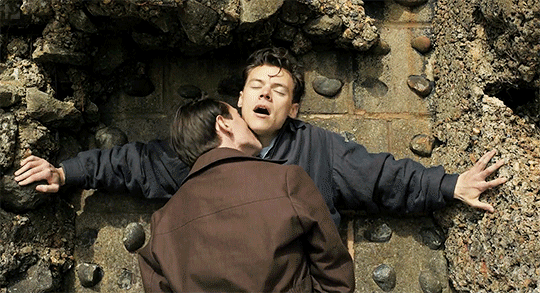
The Moon's association with fluidity, hidden depths, and possessing understanding of emotions and identity makes these actors particularly adept at portraying complex, non-traditional roles (they are great at portraying emotions at all levels of intensity in general, with a prime example being Leonardo DiCaprio [Hasta moon and Asc. moon in 1st house]), who is known to be a phenomenal actor, almost shapeshifting into whatever a movie expects of him and displaying deep, powerful emotions). However, that being the case, Ketu and Rahu might still be more prominent when it comes to this trope of casting straight men to play gay roles, possibly due to homosexuality often being seen merely as the act of having sex with other men, rather than an intimately personal aspect of identity that has an impact on all areas of an individual’s life. This has the effect of reducing gay characters to straight men more willing to engage with ideas seen as non-conventional or morally perverse (more commonly associated with Rahu and Ketu), while still maintaining their straight charm that appeals to mainstream audiences. It is easier to depict gay men as "devouring" or Ketu-like, as seen in associations with Mula Nakshatra, which is related to the act of excretion from the anus, but this narrow depiction overlooks the complexity of sexual orientation, reducing it to pure physicality of external behavior. It fails to acknowledge that being gay encompasses a broad array of emotions, experiences, and identities far beyond superficial characteristics. Moon-dominant mens’ ability to resonate with and express a wide spectrum of human experiences, including those that challenge conventional norms, is enhanced by their lunar characteristics, but these themes might also be more prone to attracting false representation due to widespread misunderstandings. I’d also like to make it known that I am aware that there are many gay and bi Moon, Rahu, and Ketu-dominant men as well; they just aren’t nearly as common and hardly, if ever, get casted in the kind of deeper gay roles I'm referring to.
Continuing this exploration, it's evident that the very qualities that lend Moon-dominant men their depth, intrigue, and warmth can also lead to significant challenges. The Moon's inherent receptivity endows these individuals with a remarkable adaptability, which, while often a strength, can manifest in less positive avenues. Their exceptional ability to influence perceptions and beliefs, a direct result of their emotional responsiveness and innate understanding of the mind's energies, can become problematic. In certain circumstances, this lunar influence may veer into darker territories with one major potential downside in particular being emotional manipulation, where their intuitive grasp of human emotions can be misused for personal gain or to sway others unduly. Their innate power over emotion and human psychology can lead them to engage in behaviors such as lying, espionage, cheating/betrayal, infidelity, illegal clandestine activities, and exploitation. The Moon's association with hidden aspects and the subconscious mind makes its natives highly skilled at navigating these activities, sometimes even leading them into antisocial or unethical paths, which can be seen in many different media portrayals I’ll cover later on. But for now, I will point to the personal life example of Ryan Philippe (Shravana asc. & Hasta mercury), who is notorious for his multiple instances of cheating on his wife and other subsequent partners, in addition to a history of drug misuse and allegations of domestic violence. An important thing to note when I speak about these things, however, is that while they can be masters of manipulation, Moon-nakshatra men do not possess complete control over the mind to the point where they always get people to do anything they want. Similar to the Moon relying on the Sun's light, their "power" actually depends on people willing to project onto and exchange energy with them, which can make Moon-dominant men extremely vulnerable, even more so than Moon women (people will instinctually try to defend moon women because they perceive them as being pure and innocent, unable to protect themselves; the same sentiment is not afforded to Moon men, who people think should be able to defend themselves with their physical power). In fact, Moon-dominant men often struggle to set boundaries due to a fear of direct confrontation as well as a desire to be what other people want of them, often worshipping the people they are closest to (they really want respect and attention from others and will endure harsh treatment or act untoward if it means getting that from someone they respect themselves, sometimes to an unhealthy extreme). That brings me to my next point of abuse... Whether inflicted or incurred, abuse (especially relating to domesticity and women) is another shadowy aspect of the Moon's influence in Vedic astrology, aligning with many of the experiences of Moon-dominant men in media and in real life. The frequent association of moon-dominant men with themes of abuse in media – be it as perpetrators, victims, or both – intertwines notions of vulnerability and aggression, showing the darker side that emotions can take, and subsequently, the darker side humanity can take as well. Overall, it makes sense why people often connect Moon men to ideas of abuse in media and in real life, such as with Evan Peters (Hasta moon and Shravana mercury) in “American Horror Story—Coven” where he was sexually abused by his mother (among other things; that show put him through it...), Christian Bale (Shravana sun) in American Psycho being abusive towards women, Tom Hardy (Hasta moon and Rahu) in “Peaky Blinders” being extremely violent and hedonistic, etc.
(Add-on: This is a bit of sensitive topic related to sexualization, so discretion is advised. Just as women traditionally face sexual objectification, Moon-dominant men may also encounter similar treatment due to their inherent passivity and receptive nature, leading to sexualization and other forms of scrutiny that stem from societal tendencies to view individuals who are more passive and receptive as feminine as being more accessible to take advantage of. This sexualization, particularly prevalent in the portrayal of these men in scenes of nudity [I've yet to find a Moon-dominant male actor who has not done a nude scene, even though many speak about how they did not want to do it at the time and felt uncomfortable] or in the adult film industry (an industry known for its connections with abuse) where I've found Moon men to be most over-represented in terms of planetary dominance, showcases a societal inclination to exploit those exhibiting traits diverging from traditional assertiveness.)
(GIF contexts: The first GIF shows Evan Peters in American Horror Story Crying. The second GIF is of Tom Hardy in Peaky Blinders smoking.)
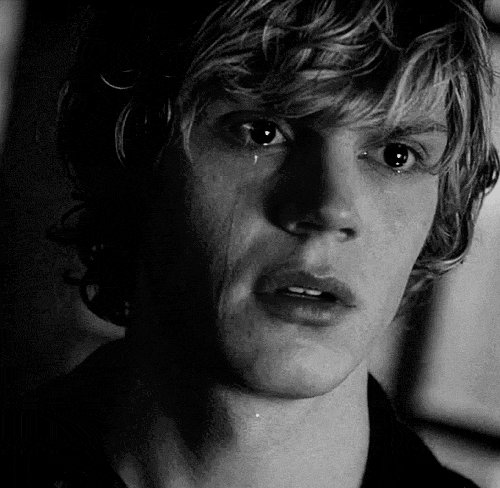

In the film industry, the energies of Moon-dominant men, characterized by their complex emotions, adaptability, and concealed depths, are astutely recognized by directors. This insight informs casting decisions, often placing Moon-dominant actors in roles that mirror the multifaceted nature inherent in them. Christian Bale's (Shravana sun) portrayal of Jim Luther in "Harsh Times" exemplifies this, exploring the darker recesses of the human psyche, a reflection of the Moon's association with concealed motives and intricate emotional situations. Similarly, Denzel Washington's (Shravana moon, Hasta asc.) performances in "American Gangster" and "Training Day" depict a tough exterior masking a softer core, Michele Morrone (Hasta sun & venus and Shravana rahu) in "365 Days" intertwines criminal elements with deep emotional entanglement, and Tom Hiddleston's (this one is super interesting because, while he doesn't have any primary moon placements, he does have Hasta jupiter & saturn— the moon nakshatra ruler and subruler of his chart plus Shravana Venus and ketu, so I consider him moon-dominant) Loki across Marvel films embodies cunning coupled with hidden vulnerability. Matt Daddario (see top of post) and Matt Bomer (Hasta moon, mercury, and rahu), in "Shadowhunters" and "White Collar" respectively, delve into the realms of a secret society of demon hunting & then crime/subterfuge with personal attachments to it, personifying the Moon's nature.
(GIF contexts: The first GIF shows Michele Morrone in 365 days shirtless and talking while looking down. The second GIF is taken from White Collar showing Matt Bomer talking frantically.)

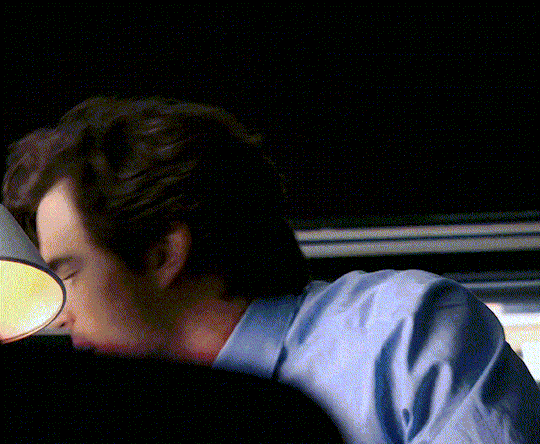
Zachary Levi as Flynn Ryder personifies this duality - mischievous yet sensitive, conniving yet protective, masculine yet feminine, seeking introspective depth yet maintaining material asperations, and so on. Followed by Henry Cavill's roles, particularly Superman and Geralt, further illustrate this theme of his invincible, hyper-masculine superhero persona of Superman veiling the sensitive, complex nature of Clark Kent that he must keep hidden through great discipline (The original actor for Superman Kirk Alyn was also moon dominant (Hasta sun and mars with a lot of his chart's energy tracing back to sun). One the other hand, Christoper Reeve– arguably one of the most popular actors to play Superman– has his Sun and Mercury less than one degree away from being in Hasta, but overall, his chart is still Sun-dominated with a lot of Uttara Phalguni and Krikita, which makes sense because one: it was old hollywood, and two: the reason people love him is for his portrayal as the hyper-masculine persona of Superman, which would have been closer to Reeve's true nature anyway. In my opinion, his portrayal as Clark Kent is kind of bad because he treats that like it is supposed to be his geeky alter-ego rather than the fact that he would have been raised as Clark Kent– the humble farm boy from Kansas, not as Superman. Anyway, rant over). And Geralt, who presents a facade of absolute masculine strength defeating monsters for a living and projecting a sense of detachment from others, all while concealing a deeper, more nurturing and intimate side of himself. These portrayals, necessitating depth and often grappling with themes of manipulation and other complex moral dynamics, go hand-in-hand with the Moon's influence on hidden emotional strata and ethical complexities. The performances of these actors align with the experiences of many Moon-dominant men, reflecting the nature of their personalities. (Thank you so much to anyone who read this entire thing! 🙂 I know it’s a ton of information to get through, so I do really appreciate any time and effort people put into reading this!)
#vedic astrology#astrology#astrology observations#nakshatras#zodiac#astro community#astro notes#astro observations#zodiac signs#astrology notes#vedic chart#vedic astro observations#vedic astro notes#vedic texts#vedic mythology#lagna#astro placements#astroblr#sidereal astrology#capricorn#virgo#taurus#moon men#moon-dominant men
173 notes
·
View notes
Note
Hello! I hope your week has been kind. I would like to ask, in s2 ep9, we see Lois with amnesia interacting with Clark, or rather Kal-El, who in the simulation was raised on Krypton rather than on Earth. What do you think of an AU where in a futuristic Earth, humans attempting the first interstellar travel across space, intrepid reporter Lois Lane was chosen to represent journalism amongst the space crew, only to get separated by some accident and crash landed on Krypton, which, I think would have gone full isolationist. Where she was taken into captivity and meets Kal, and bonding ensues. What do you think of that AU? And how would you write it, if you don't mind me asking? Kara would be there.
Drink water regularly, and eat your vegetables daily.
Hi! Sorry it's taken me so long to get to this ask!
An isolationist Krypton actually isn't that far off from (at least Byrne-era) comics canon! As I've mentioned before while talking about the origins of the Eradicator, there was a significant period of Krypton's history where it was isolationist and xenophobic, and this lead to the Eradicator affecting Kryptonian genetics to prevent the majority of Kryptonians from being able to leave the planet.
I love the idea of a culturally Kryptonian Kal, because like, while obviously comics canon says that Clark got his kindness and his morals from Ma and Pa Kent, I do like speculating how he would kind of... find his way to that in AU's where they don't raise him. I think to make this AU really work, you'd need to make Jor-El and Lara kind of amalgams of their Donner Movie, House of El Graphic novel series, and Superman: TAS depictions: Noble, kind, and (by Kryptonian standards) romantic and rebellious! I've always like the idea that Kal does have inklings of their personalities, even if he's culturally earthling. I do think one of the things that really hurts about MAWS is we see Jor-El as more of a disillusioned general than a doomed scientist prophet and I loooove scientist Jor-El, I love the anguish of "We're fucked but maybe we don't have to be completely fucked." But--okay, steering back to your AU.
I mean if I was going to write an AU like that, I'd be working a lot from Byrne's Krypton with a heavy dash of Bronze Age Krypton rather than MAWS Krypton. It's not that I don't like MAWS Krypton, it's just I feel there's a lot less we know about it. What we do know about it are from heavily unreliable narrators (Jor-El, Kara, Brainiac). Meanwhile, Byrne's Krypton has that all-important moral ambiguity, while Bronze Age Krypton has a lot of fun sci-fi and linguistic tidbits, so I feel like I'd be able to put together a more immersive fic experience from that. I could still keep the MAWS characterizations, mainly by making the House of El a house that fell from grace as a result of Jor-El being mistaken in his prediction of Krypton's destruction, à la "The Man Who Has Everything." Hell, I can even keep that "Kal-El as the first natural Kryptonian birth in centuries" characterization, which I talk a lot about here, but basically I can use the cultural taboo of that as a means to give Kal that all-important loneliness that informs his kindness and deep need to prove himself. So basically in this AU, Lois is seen as essentially a HORRIBLE BIOHAZARD, and the only people who are willing to deal with her are the DISGRACED WEIRDOS of the House of El. Jor-El largely sees her as a scientific curiosity, Lara is mostly concerned about her son's fixation with this alien when he's already bullied and isolated enough for being a natural birth, and Kal has just laid eyes on THE MOST BEAUTIFUL BEING IN THE UNIVERSE.
17 notes
·
View notes
Text
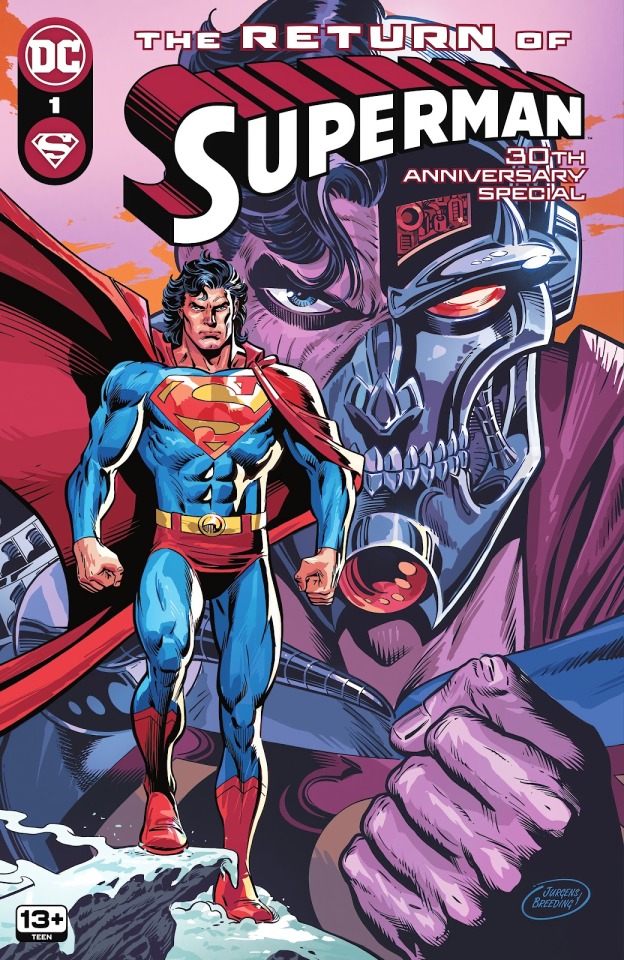
The Return of Superman 30th Anniversary Special (November 2023)
Whoa! Some sort of chronal disturbance has thrown us from 1994 to the futuristic year 2023, just in time to cover this new special by the entire creative team behind "Reign of the Supermen"... minus Roger Stern and Dennis Janke, but PLUS Jerry Ordway (who left right before "Reign" started in '93). This is a lot like the Death of Superman special released last year, except that instead of featuring four standalone stories, this one has a framing device uniting all the tales.
In the framing story (written by Dan Jurgens and drawn by Travis Moore), the Cyborg Superman comes back to Metropolis and starts attacking S.T.A.R. Labs installations, as if those places haven't been blown up enough times already. Since Perry White is currently in a coma (from, as far as I can tell, not knowing Superman is Clark Kent), it's up to current Daily Planet editor Lois Lane to put together a story on the Cyborg without her mentor's help. Or with a little bit of her mentor's help, since Ron Troupe conveniently pulls out Perry's old journal from the "Reign of the Supermen" days, including his thoughts about the Cyborg.
So, Lois and Ron start reading Perry's notes about the four Supermen who popped up in Metropolis after Superman's death, which leads us to...
"Speed" (by Louise Simonson and Jon Bogdanove)
Despite the "Perry's notes" framing device, this story is actually told by Ron as he remembers the first time he saw Steel. Ron is leaving for work one morning and everyone in his neighborhood is talking about which of the four Supermen is the real deal. A lady called Mama Bess (who I initially mistook for Myra the Orphanage Lady because she's also big and black and surrounded by little kids) says they're all posers, including Steel, because none of them are around when you need them. Then some gangbangers drive by the neighborhood with a Toastmaster gun, and guess who drops by to save everyone's asses? Not Batman.

Mama Bess recognizes Steel's voice ("rich an' dark as Memphis honey") as belonging to that guy who was running around Metropolis helping people in crumbling buildings while Superman and Doomsday were tearing up the town, as seen in the Death special. While Steel fights the gangbangers, Ron calls Perry, who tells him to keep that lady talking so they can learn as much as possible about the mysterious armored Superman. Hey, is that Mike Carlin in the Planet offices below, to the left of adorably skinny Jimmy Olsen?

Steel prevails over the evildoers and the neighborhood kids rush in to proclaim him as the one true Superman. The best part of the story, for me, is when a little kid picks up a Toastmaster laying on the street and says he can use it to stop the bad guys, but Steel says that's a weapon for bad guys (he'd know, he designed them). Then he replaces it with an old school Game Boy and breaks the gun, Dark Knight Returns-style.
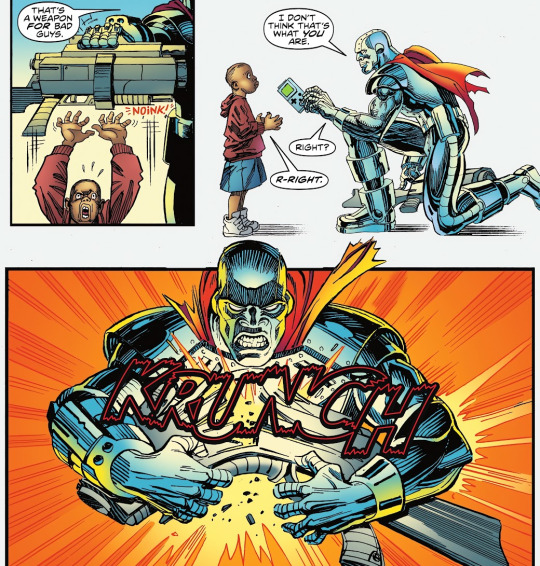
Steel tells everyone he's not Superman, he's just a dude trying to help, but Mama Bess still insists on making him a new cape to replace the one that got torn up in the fight. Ron concludes his report saying that this guy isn't the real Superman, "but maybe he was the next best thing."
"He Had Me Thinking He Was Superman" (by Jerry Ordway)
Jerry Ordway fills in for Roger Stern and Jackson Guice (who at least has a pin-up in this issue) and, man, I never knew how much I needed to see Ordway draw the Eradicator until now. In this story, Perry stumbles upon a standoff between Maggie Sawyer's Special Crimes Unit and the most violent yet Spock-like of the four Supermen, who's holding an armored goon hostage as he interrogates him.

Maggie kindly kicks Perry out of the active crime scene, but he sticks around and decides to solve this situation via the power of journalism. First, Perry talks to a warehouse worker (who kinda looks like an Amalgam of High Pockets and Lamarr) and learns about a nearby entrance to a rumored Intergang hideout. Then, he uses a radio scanner to find the frequency the goons' friends are using to communicate. He tries to tell Maggie about this, but the Superman Formerly Known As The Eradicator grabs Perry and flies off with him to find out what he knows. Perry says he'll tell him if he promises to stop being such a psychopath for a moment.

Thanks to Perry's information, the Eradicator finds the other armored goons, who are moving weapons from an abandoned Intergang cache. The Eradicator violently (but non-lethally, as promised) encourages the goons to renounce their criminal ways, and then locates the mastermind behind this operation, who turns out to be... no, not freakin' Psi-Phon and Dreadnaught, but close enough: Professor Killgrave! You know, that little twerp with the Moe haircut who once trapped Superman in an amusement park full of killer robots. Having seen how the Eradicator dealt with his hired goons, Killgrave eagerly gives himself up to the authorities.

As the Eradicator flies away from the underground base, he carelessly sends some debris flying off which almost hits some bystanders and ruins Perry's car. So, the Eradicator fulfills his promise to Perry that he wouldn't kill anyone, but Perry decides he can't keep his side of the deal, which was to tell the Planet's readers that "they have nothing to fear" from this dangerous maniac.
"The Metropolis Kid" (by Karl Kesel, Tom Grummett, and Doug Hazlewood)
This story provides the secret origin for several Superboy-related elements: the name "The Metropolis Kid" (which never made a lot of sense to me), that iconic pinup of Superboy saving a lady in a bath towel, and Mack Harlin, a recurring character who first appeared in the Superboy series in 1995. Turns out he was a Metropolis cabbie before he somehow became a truant officer in Hawaii. Note that Mack also counts as the second Mike Carlin cameo in this issue.
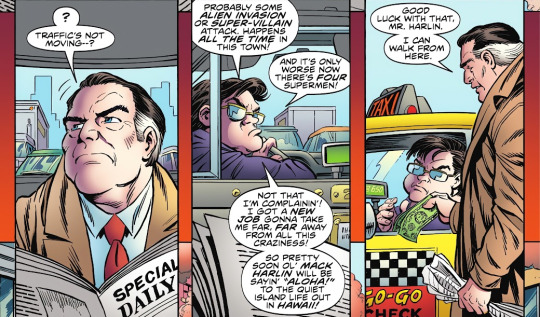
(Wonder if the ride was $6,50?)
In the story, Perry witnesses the moment when Don't Call Me Superboy saves that towel lady from a building fire (which she didn't notice due to her love of '90s rock, waterproof earbuds, and long, hot showers). Tana Moon's photo of that moment goes viral on Tweeter, FaceSpace, and, yes, even Insta-image, turning Not-Superboy into a social media sensation. The official story is that the Kid is Superman's clone, but Perry doesn't seem convinced. He uses his journalistic powers to find Not-Superboy at a local skate park where he hangs out. Interestingly, Perry briefly wonders if the Kid reminds him of his late son, Jerry, before dismissing the idea. I wonder if that's Kesel commenting on a certain 2000s retcon that made Superboy and Jerry biological half-brothers...

While Perry watches the Kid being a kid, he's suddenly attacked by Bloodsport -- the original one from John Byrne's Superman #4, who just busted out of jail, and not the racist wannabe. Instead of teleporting guns into his hands, this time Bloodsport is wearing a "weapons suit" that allows him to quickly assemble them on the fly. One of the guns hits Not-Superboy pretty hard, but the persistent little bugger gets up and somehow manages to disassemble Bloodsport's suit just by touching it.

As Perry later determines, Bloodsport thought the bullets would kill Not-Superboy because they were coated with a tiny bit of kryptonite, but it didn't seem to have an effect on him. That's when Perry realizes who the Kid reminds him of, with his brash attitude, big heart, endless energy, and massive potential: not Jerry (ouch), but Metropolis itself. Hence, the Metropolis Kid. Eh, I'll take it.
"Betrayal" (by Dan Jurgens and Brett Breeding)
This one begins between the pages of Superman #79, after the Cyborg Superman saves the President from terrorists but before the Planet publishes Ron's soon-to-be-infamous front page proclaiming "SUPERMAN IS BACK!" How could Perry let that story through? As it turns out, at first he didn't wanna. Perry tells Ron he needs way more proof that the Cyborg is the real Superman. That proof sorta falls on his lap when the train Perry is riding gets derailed and the Cyborg heroically saves everyone. That, plus the Secret Service vouching for this guy, are enough to convince Perry that he's definitely Superman and not an evil impostor or something.

(Note that the story makes sure to mention the "living former presidents" happened to be at the White House when the Cyborg dropped by, explaining why the Planet's front page shows Bill Clinton and not, uh, whoever was President in the DCU "a few years ago.")
So, Perry goes ahead with Ron's front page story... only for the Superman he endorsed to turn around and murder 7 million people in Coast City. Whoops. Continuity quibble: this story makes it sound like the Cyborg was immediately revealed as Coast City's murderer, when in fact he fooled everyone into thinking it was the Eradicator for several days, but maybe Perry saw through it right away because he's just THAT good of a journalist.
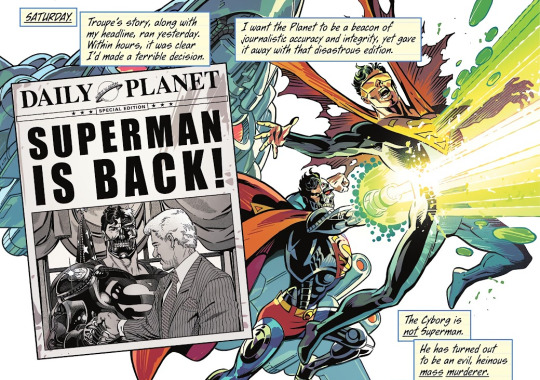
Perry feels awful about that front page, especially when it emerges that the Cyborg and some big yellow guy called Mongul are turning Coast City's crater into a giant engine to turn Earth into a sort of Death Star. Just when Perry is at his lowest point, Lois tells him that another Superman showed up in a Kryptonian battle armor, and this time she just knows he's the real deal (because she made out with him, but she doesn't mention that).
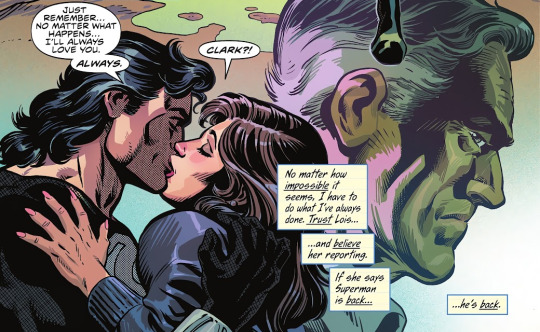
We see the rest of the storyline (the assault on Engine City, the Cyborg's defeat) from Perry's perspective, and once Superman is back in Metropolis, Perry tells him how sorry he is for that headline. Superman's like "nah, don't sweat it, honest mistake" and actually thanks Perry for always reporting on him with honesty over the years. Moral of the story: trust Lois, double-check Ron.
"Legacy" (by Dan Jurgens, Travis Moore, and briefly all the others)
Meanwhile, in the framing story, Superboy, Steel, and a recently-rebooted, non-evil Eradicator (or his Phantom Zone ghost, anyway) show up to stop their old pal the Cyborg, since Superman is currently in space. We learn that the Cyborg has been hitting S.T.A.R. facilities because he wants to retrieve the DNA of his three astronaut friends who were mutated into freaks during the fantastic incident that gave him his powers, so he can bring them all back to life. The Supermen understandably assume that he's building some sort of weapon and try to stop him, but he's defeated all of them before and does it again.

Royally pissed that these meddling Supermen messed with his plans, the Cyborg notices their fight left some exposed gas lines in the middle of Metropolis and is about to use them to indulge in his favorite hobby: blowing up entire cities. Luckily, the Eradicator uses some of Steel's tech to make his hologram self solid enough to whip out a Phantom Zone projector and suck the Cyborg into his ghostly prison.
As soon as the day is saved, Superman flies down and reveals that he'd been watching all along but didn't intervene because he had confidence in his boys. Everyone shares a nice little moment, until the Eradicator makes it awkward with his talk of "Kryptonian purity."

The issue ends with Lois reading a passage from Perry's journal about how Superman inspired others to be better, even in his absence. She hopes she's able to tell Perry that the same thing is true about him, because "you are our Superman." Well, their other Superman.
Like the Death special, this is an excellent excuse for these legendary creators to play with their most famous toys again, and I wouldn't mind seeing one of these a year (Battle for Metropolis 30th Anniversary Special, anyone?). I kinda wish the Supermen had been introduced more gradually/dramatically in the framing story, building up to a grand reunion, instead of being like "oh hey, there they are," but that's a minor complaint and doesn't detract much from this massive labor of love. However, there's one thing I can't forgive: still no Bibbo. -1/10.
Fun fact, my co-host Don Sparrow and I agreed we'd make this post much shorter than the insanely long one we did for the previous special, and it ended up being... about 10% shorter. Woo! We did it! See Don's take after the jump:
Art-Watch (by @donsparrow):
We begin with the cover, and it’s a great piece from the formidable team of Jurgens and Breeding. We’ve mentioned in the past the rumour that there had been a falling out between this pencil and ink team in years past, so seeing their layouts and finishes together sure feels like a treat. The composition is reminiscent of the image we used to have as the background on this very blog. I must say, I’m not a fan of the colouring technique employed here by Elizabeth Breitweister, which looks a little flat and scribbly for my tastes. The sky in particular just looks like a photograph with the contrast turned way up, and then colour filled, and doesn’t really work for me. But that’s just my opinion, I’m sure the colouring approach to this cover has many modern fans.
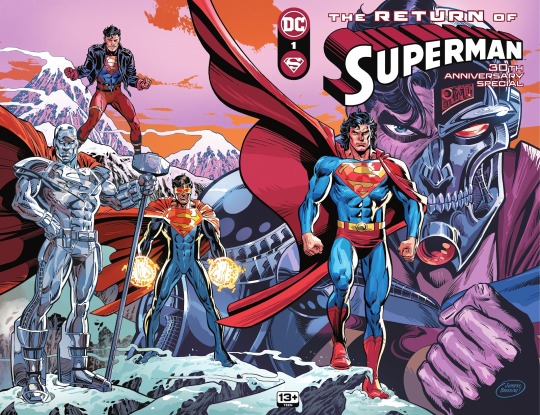
Inside the main through-line story is by Travis Moore, and it’s mostly quite well done, if a little stiff in places. He has a great handle on Lois Lane, and the "Reign of the Supermen" splash on page 5 is a particular highlight. I’m less enchanted with the modern-day Cyborg Superman, particularly the torn sleeve on his right arm, and the missing belt buckle. There’s generally a simplicity to the complex robotic parts that doesn’t work as well as other incarnations we’ve seen of the Cyborg Superman.

The next sequence, a reminiscence of Steel’s early days is a great showcase of Jon Bogdanove’s late style, some of which we saw in the “Retroactive” throwbacks of 2011. While Bog still employs his cartoonish rendering, the figures are generally tighter and smaller on the page than his '90s work. Fittingly, given the extra attention paid to Metropolis’ diversity in the pages of Superman: The Man of Steel, this story makes good use of a predominantly black Metropolis neighbourhood. While I’ve never fully warmed to Ron Troupe as a character, this story does give him some background, showing his neighbourhood and living situation in a way that wasn’t covered by his appearances in the '90s. (As Ron is heading to work, he’s wearing a suit and tie, though I would have loved a callback to his famed JAM sweatshirt, first appearing in the story that THIS story refers to, where Ron is involved in the verification of the Cyborg Superman as the “one true Superman”). There’s a terrific image of John Henry Irons flying at the camera on Page 11...
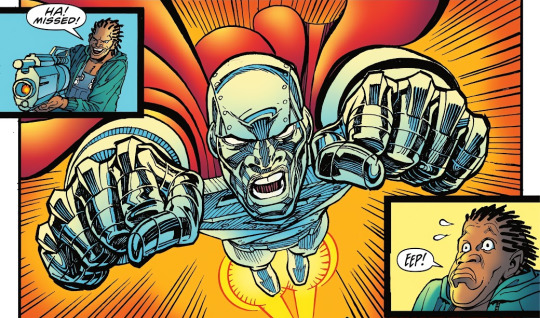
...and another of him destroying a toastmaster weapon on page 16 that is a standout, featuring Bog’s unique method of hatching to denote the shine of chrome. Including something like a smartphone, as they do on page 16, is an effective way of moving the story up in time, so that Lois Lane isn’t in (at least) her fifties, having covered Superman’s return in 1994. The involvement of specific Presidents later in the book hamper that slightly, but overall they do a good job of keeping it nebulous.
It was difficult to pick a favourite sequence, but I have to give it to the Jerry Ordway Eradicator story. It’s interesting to see a story by Jerry with this character, who was mostly covered by other writers (indeed, Jerry was off the books immediately after Adventures #500) and artists. Ordway hasn’t lost much zip on his fastball, as the entire story employs the usual dynamic realism and well-observed textures that we’ve come to appreciate in his work. Perry looks like himself throughout, though he reminds me of Rodney Dangerfield in the one panel of him playing with his analog walky-talky. The Eradicator’s costume has always been a terrific design, and he looks so cool as he searches for the rest of the baddies in an underground lair.
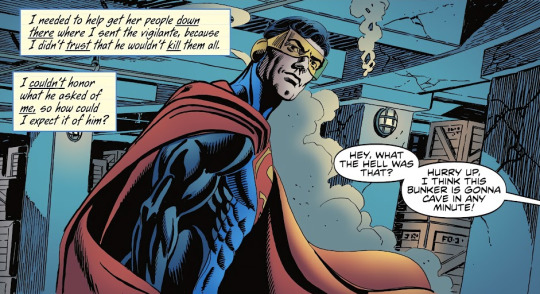
Later in the story, the image of the Last Son melting through the getaway car is an extremely tall order art-wise, and again Jerry doesn’t disappoint. As one of the two biggest fans of the triangle era, I was overjoyed to see an old-school villain like Killgrave in these pages as well.
We’re similarly treated to another original triangle era villain in the Kesel-Grummett-Hazlewood section, where Kon-El throws down with Bloodsport. While it may feel like rehash to some readers of this blog, it’s been decades since readers have seen “The Metropolis Kid” rescue Ms. Sheenan, so it’s an appreciated callback. Lots of great stuff here, but none I like more than Superboy shredding on a skateboard—a TOTALLY RAD moment, if ever.

The next section, like the cover, is something of a missed opportunity. Again, we have a stellar pairing of Jurgens and Breeding, but the art is let down by what I would say is incompatible colouring. Most of the tones are good, but the details begin to compete with the linework underneath, especially as the digital brushstrokes get scribbly, as they are on the arm of the Cyborg Superman on the title page, or perhaps worst of all, the should-be-impactful moment of the one true Kal-El emerging on Metropolis harbour. Superman is depicted red-nosed throughout, and the rendering is sketchy, where even flat colour might have given us a better look at the inks below. I get the feeling it’s all intentional—an attempt at a more painterly style, perhaps to denote that it’s a flashback. But it was a miss for me—even though I always love seeing Mongul kissing the Cyborg’s hand. [Max: He does have a very handsome hand.]
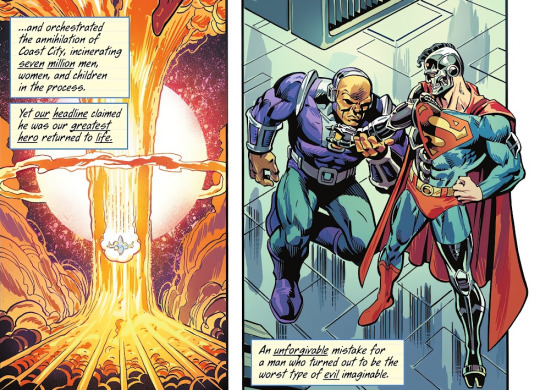
Next to Ordway’s chapter, the high point of the book is where the triangle era super-team switch, page to page, in order to tell the story. First with Jurgens and Breeding (with a less distracting colouring job), then Bogdanove, then Ordway, and finally Grummett and Hazelwood. Interestingly, the classic Superman plays no role in the fight, showing up only at the end, in an echo of the original storyline.
Finally, there’s a pin-up section, with some real standouts. While the Stern/Guice team didn’t get their own chapter in the book, that title is represented with a great image of the survival suit Superman taking flight in front of the Daily Planet. The comics logic part of my brain can’t help but notice he’s NOT wearing the Lexcorp flight boots in this image, and wasn’t able to fly under his own power in this suit, but I’m resisting pointing that out. The Daniel Sampere pinup is another nice, simple image but again I quibble, as the survival suit Superman had no cape. Is that maybe the Cyborg’s cape? It was also deeply cool to see all the trade dress and character logos at the back of that section. [Max: And the Kerry Gammill/José Luis García López promo image! Been a while since we've seen Gammill in this blog so that was a nice surprise for me.]
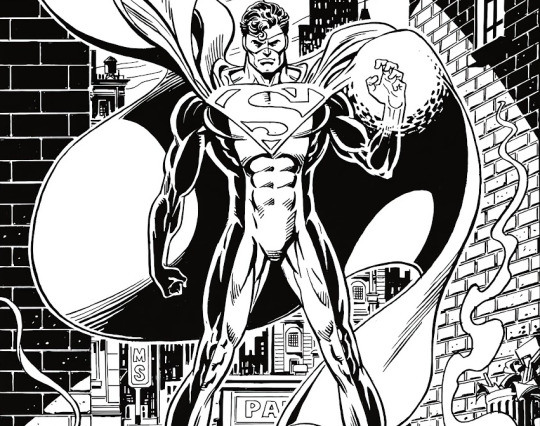
SPEEDING BULLETS:
I love that this story showcases Perry White’s regret about running Ron’s story that lent credibility to the murderous Cyborg Superman. They never really dealt with the journalistic repercussions of that within the story, so I love seeing an added dimension through this new narrative. They also absolve the Clintons more specifically, as the Cyborg notes that all Presidents vouched for his veracity, so it wasn’t just slick Willie who got it wrong.
I realize the Travis Moore pages are mainly a narrative device to set up the flashbacks, but there’s something off about someone as deadly as the Cyborg just aimlessly shooting up the city. As we saw when he took Doomsday’s body in Superman #78, with his power set, and technological ability, Henshaw can get in and out of a very secure place with speed and stealth, none of which do we see here. The dissonance isn’t helped by the art, which shows very empty streets for a usually crowded literal Metropolis.
The use of Perry White’s diaries as a framework for the flashbacks is a super idea, and puts a beloved character at the center of the issue, even if he’s physically absent in current day comics. (Having dropped the super-books during the Bendis run, I confess I was a little lost on that score.)
Not familiar with the skateboard term “Grommet” but it pays off on the last page of the section as Superboy gives a skateboard to “Tommy the Grommet” in a shoutout to artist Tom Grummett.
The idea of the Cyborg resurrecting the rest of his crew is an intriguing one, and it does make me wonder what an insane mirror image Fantastic Four would be like as opponents of Superman. Certainly it would even up the odds a little, as the Super squad we see in these pages had no trouble handling Henshaw on his own. [Max: I like that idea. Call them the Tragic Four.]
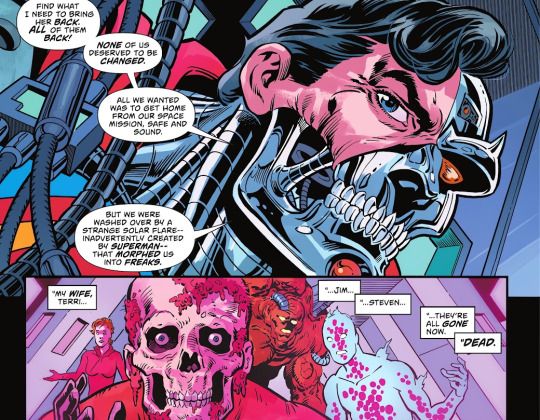
Overall I think I liked the Death anniversary issue a little more, as the story felt a bit more urgent than just window-dressing for flashbacks. But both are like meeting an old friend after a long time. This really was a high-water mark for Superman stories, and for comics in general.
#superman#dan jurgens#travis moore#louise simonson#jon bogdanove#jerry ordway#karl kesel#tom grummett#doug hazlewood#brett breeding#reign of the supermen#hank henshaw#superboy#steel#eradicator#ron troupe#professor killgrave#maggie sawyer#mack harlin#bloodsport#intergang#special crimes unit#perry white#tana moon#mongul#coast city#awesome kryptonian battle armor#s.t.a.r. labs#not myra#not high pockets and lamarr
24 notes
·
View notes
Text
The Weight of Your Heart
by Vera27
After returning from Tartarus, Bruce tries to ignore what form his attraction to Bekka took, and why she felt, tasted, and smelled of someone else.
Or
Bruce just wants to pine in solitude. Too bad people are disappearing left and right, and the Justice League needs a detective.
Words: 4614, Chapters: 1/6, Language: English
Fandoms: DCU, Superman/Batman (Comics), Batman - All Media Types, Superman - All Media Types
Rating: Explicit
Warnings: Creator Chose Not To Use Archive Warnings
Categories: M/M
Characters: Bruce Wayne, Clark Kent, Alfred Pennyworth
Relationships: Clark Kent/Bruce Wayne
Additional Tags: SuperBat, Friends to Lovers, Pining, Extreme Pining, Angst, Hurt/Comfort, Mystery, Continuity What Continuity, an amalgamation of hand-selected canon, takes place after Superman/Batman #42, Kinda, with gaslighting, no beta we die like Lois in Injustice, sorry - Freeform
via https://ift.tt/5YW273J
2 notes
·
View notes
Text
The Weight of Your Heart
read it on AO3 at https://ift.tt/tLbw8da
by Vera27
After returning from Tartarus, Bruce tries to ignore what form his attraction to Bekka took, and why she felt, tasted, and smelled of someone else.
Or
Bruce just wants to pine in solitude. Too bad people are disappearing left and right, and the Justice League needs a detective.
Words: 4614, Chapters: 1/6, Language: English
Fandoms: DCU, Superman/Batman (Comics), Batman - All Media Types, Superman - All Media Types
Rating: Explicit
Warnings: Creator Chose Not To Use Archive Warnings
Categories: M/M
Characters: Bruce Wayne, Clark Kent, Alfred Pennyworth
Relationships: Clark Kent/Bruce Wayne
Additional Tags: SuperBat, Friends to Lovers, Pining, Extreme Pining, Angst, Hurt/Comfort, Mystery, Continuity What Continuity, an amalgamation of hand-selected canon, takes place after Superman/Batman #42, Kinda, with gaslighting, no beta we die like Lois in Injustice, sorry - Freeform
read it on AO3 at https://ift.tt/tLbw8da
5 notes
·
View notes
Text
Epiphany: suppose the teenaged Jon Kent is of Earth-0 but from the Superman Reborn timeline, while the younger was born during Convergence as we all read. Superman Reborn had exactly zero consequences on anyone's history, save Clark and Lois, even Jon. Jon didn't get reduced to two orbs and remereged into a singular being combining the whole histories of his parents to match his. His parents experienced a hypertime no one else in the universe did.

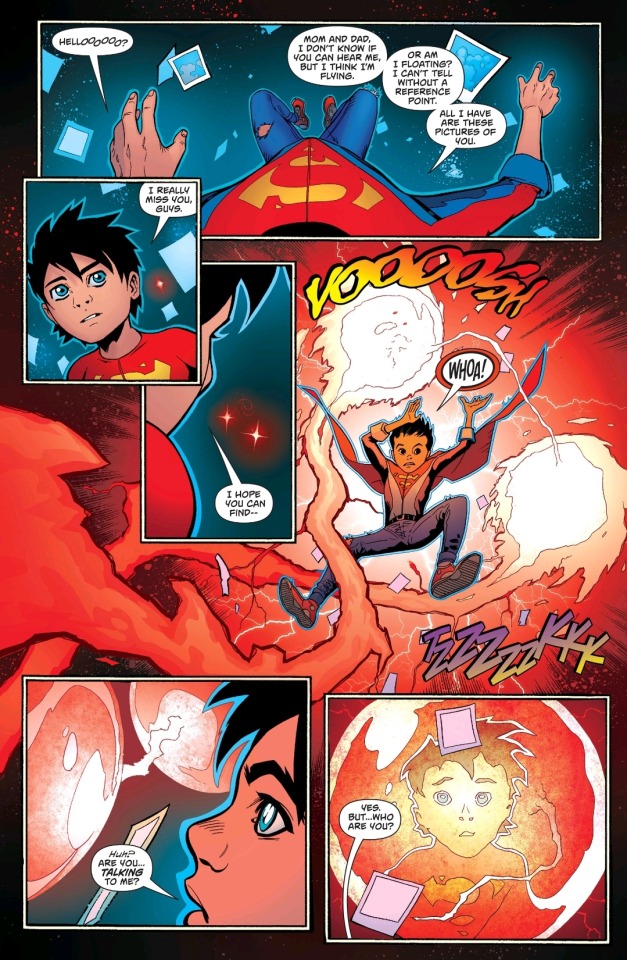
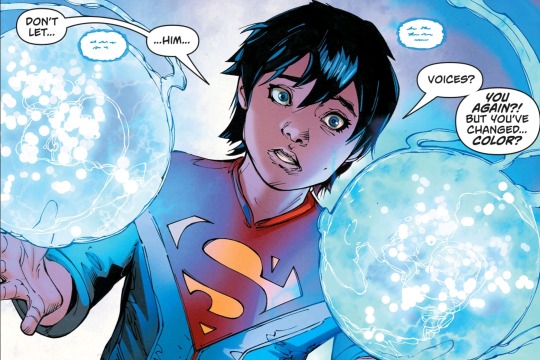

That could mean the reason Harvest was crucified in RHatO and SoKE makes allusion to Superboy (2011) is because the Teen Jon is whatever amalgamation became of Lobdell’s Superboy from that timeline, though the original could still be out there somewhere.
#dc comics#dc#superman#superman reborn#superman rebirth#superboy#jon kent#jonathan kent#jonathan samuel kent#jonathan lane kent#super sons
19 notes
·
View notes
Note
Considering your recent musings on worldbuilding, fantasy, and magic realism, would be interested to hear your thoughts on superhero worlds, where practically all those subgenres crossover (soft science fiction for the technology, dark fantasy/horror for the magic, high fantasy pantheons loosely based on mythology and entirely made-up and genre-busting ones, space opera for the occasional interstellar travel, etc.) and yet from some point on it gets merged into the background of an universe supposed to be just like our world until noted otherwise (particularly in social trends, etc.), in true magic-realist fashion.
i gotta say, superheroes are just... basically uninteresting as a concept to me. whether you're deconstructing or reconstructing or playing it straight, you have to torture basic narrative plausibility (irrespective of SF/fantasy/realist plausability) to make the genre function that i simply tend to lose interest.
also, i don't think "a universe supposed to be just like our world until noted otherwise" is a very good definition of magical realism. magical realism is, IMO, about emotional logic overwhelming other systems governing the narrative at specifically heightened points, in a way that should break those systems (but apparently does not). but not everywhere in the narrative (that's more like surrealism), and typically not in ways that are marked as unusual within the narrative (characters don't go "wow, that was weird/amazing/terrifying!"). your definition seems to me to be a better definition of "low" or "urban" fantasy, or certain kinds of near-future science fiction, than magical realism.
because in superhero fiction, the weird/amazing/terrifying nature of the fantastical elements are part of the point. superman is a hero because he is remarkable and, well, superhuman. it would only be magical realism if clark kent was an ordinary guy who one day caught a building that was collapsing and saved lois lane because of his overpowering love for her, and his sense of personal alienation from the rest of the human race, and everyone acted like this was pretty normal and it was never brought up again. as soon as you make him an alien, as a causative factor in his supernatural abilities, you just have regular science fiction.
i do think it's kind of fun that the superhero genre is one of those genres that borrows freely from others--narratives where tropes from horror, fantasy, and science fiction can coexist comfortably are neat. i have friends who are english major types, you know, real insufferable book nerds, who speak of the superhero genre not unlike you do: they evoke the image of a febrile amalgam of different artists in the same shared universe, where the contradictions and paradoxes only add to a kind of semi-surreal character; and of more independent auteur-style projects like Watchmen and Worm which comment cleverly on established tropes of the genre.
but whenever i dip my toe into superhero fiction of any flavor, i feel less that i'm sampling from a roiling cauldron of imagination too rich to be contained by any single narrative approach and more that I am tasting a bland wafer of something whose foundational characters and stories were almost instantly converted into an undifferentiated paste by particular commercial and cultural demands; and rather than injecting new and exciting material into that paste, most innovations in the genre have taken that paste and tried to sculpt it, like making little sculptures out of spam and calling it cuisine.
this is not to say i have never enjoyed a superhero movie; just that even the works praised as daring innovators within the genre seem to me to be basically more of the same. like licensed star wars media or video game tie-in novels, it's incredibly difficult to transcend the limitations of your genre when the thing that crystallized the genre in the first place, the thing that has your audience present in the first place, are those limitations. i don't think it's possible to make a superhero story very interesting for the same reason it's not possible to build the burj khalifa out of spam: spam is not steel, and in order to make spam have the properties of steel, it would have to cease to be useful as spam.
28 notes
·
View notes
Photo

, It’s been a couple days and I’m still losing my mind over the Multiverse catalogue
Earth-54 is obviously wrong ofc
But also: a lot of the high numbers (E-59, 124, 148, 162...) are actually existing Pre-Crisis canon, and E-46 is either a weird gag or a tease for an unannounced Elseworld book bc “The Gargoyle of Gotham” doesn’t exist irl
The coy acknowledgement of Amalgam Comics is fun tho, and I looked up the issue for E-2020, and apparently--as of 2020 by way of 1980--Clark was supposed to have a grandson named Kalel Kent who lived in a floating New Metropolis city, also his grandmother isn’t specifically Lois and his mom isn’t named at all, but he is specified as partially human, so who knows.
idk filling out the Unknown Worlds from Multiversity is fun from a lore perspective, but using mostly Elseworld series that have come out since that book finished smacks a bit of advertising. Mostly the Tom Taylor stuff being so prevalent, that dude is everywhere.
7 notes
·
View notes
Text




Dark Claw and Super Soldier of the Amalgam Universe in the style of the DC Animated Universe by Blinky Productions Inc.
From February to April 1996, DC and Marvel published the inter-company crossover series ‘DC Versus Marvel’ where both represented two different beings called "brothers". In order to decide which brother's universe remained, a character from DC and Marvel battled in the comics series, the winner resulted from actual readers' votes. Prior to both brothers deciding the other was an essential, between issues 3 and 4 of the 4 comic arc, an amalgamated universe (the merging of DC and Marvel characters) was created for a short period of time. During this mini series, originally 12 amalgam comics were published under the Amalgam Imprint based on the combined characters (24 created in total), including Logan Wayne aka Dark Claw (DC’s Batman and Marvel’s Wolverine) created by Larry Hama, Jim Balent, and Ray McCarthy and Clark Kent aka Super-Soldier (DC’s Superman and Marvel’s Captain America) created by Mark Waid and Dave Gibbons.
2 notes
·
View notes